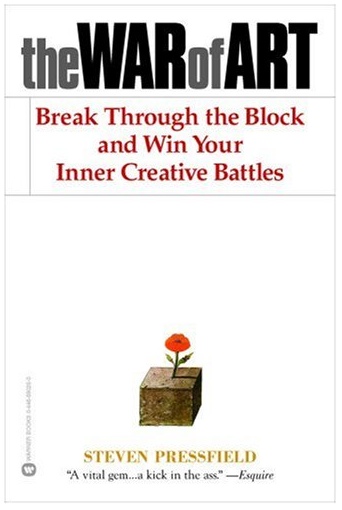by Steven Pressfield
In his book The War of Art: Break Through the Blocks and Win Your Inner Creative Battles Pressfield radically redefines the term resistance by taking it from a general condition that can easily be diagnosed in other people to the identification of a force we all have to struggle with.
His point of view is best summarized with the following quote: “Resistance seems to come from outside of ourselves. We locate it in our spouses, jobs, bosses, kids.” But in truth, as he continues: “Resistance arises from within. It is self-generated and self-perpetuated. Resistance is the enemy within.”
Some highlights and notes that I made while reading this book:
– Make sure to watch the TED presentation by Elisabeth Gilbert because she approaches art, muse and genius in the same way.
– The more important a call or action is for the growth of your soul, the more resistance you will feel;
– When the finish line is in sight the resistance is about to go through the roof;
– 2 ways to fight resistance: Fundamentalism (looking backward) and Creation (looking forward)
– Fear is an indicator: go there.
– Rational justifications are the worst sign of resistance (because they make your giving in so “reasonable”)
– Hierarchical versus Territorial: where do you look for validation of your actions? To an authority figure outside of yourself, or to the labor itself and the territory it is spent on?
– An artist, like a mother, is humble because she knows she is only a vehicle and not an originator.
In his own biography Pressfield notes the following thoughts on art and artists:
“I believe in previous lives and the Muse—and that books and music exist before they are written and that they are propelled into material being by their own imperative to be born, via the offices of those willing servants of discipline, imagination and inspiration, whom we call artists. My conception of the artist’s role is a combination of reverence for the unknowable nature of “where it all comes from” and a no-nonsense, blue-collar demystification of the process by which this mystery is approached. In other words, a paradox.”
FINAL NOTE: I started to read this book after attending the Linchpin conference by Seth Godin. In Linchpin Godin refers to the voice in the back of our head telling us to back off, be careful, go slow, compromise. He calls it the lizard brain. It is writer’s block and every project that ever shipped late because people couldn’t stay on the same page long enough to get something out the door.
Godin uncovers the lizard brain as the motor of mediocrity and the main responsible for late launches, middle of the road products and procrastination. It is the force that causes you to fit in instead of standing out. Godin got the inspiration for the lizard brain straight from Steven Pressfield book The War of Art.



